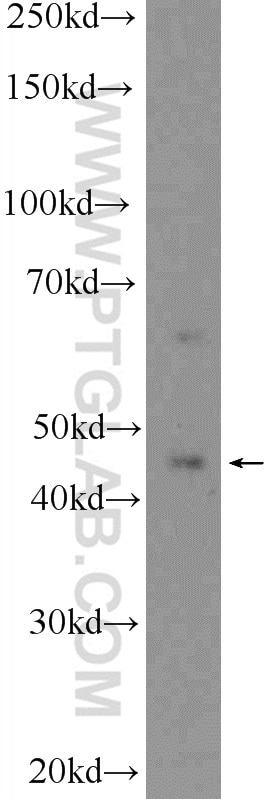Tested Applications
| Positive WB detected in | human testis tissue |
| Positive IHC detected in | human testis tissue Note: suggested antigen retrieval with TE buffer pH 9.0; (*) Alternatively, antigen retrieval may be performed with citrate buffer pH 6.0 |
Recommended dilution
| Application | Dilution |
|---|---|
| Western Blot (WB) | WB : 1:500-1:2000 |
| Immunohistochemistry (IHC) | IHC : 1:20-1:200 |
| It is recommended that this reagent should be titrated in each testing system to obtain optimal results. | |
| Sample-dependent, Check data in validation data gallery. | |
Product Information
11970-1-AP targets HSFY1 in WB, IHC, ELISA applications and shows reactivity with human samples.
| Tested Reactivity | human |
| Host / Isotype | Rabbit / IgG |
| Class | Polyclonal |
| Type | Antibody |
| Immunogen |
CatNo: Ag2592 Product name: Recombinant human HSFY1 protein Source: e coli.-derived, PGEX-4T Tag: GST Domain: 1-214 aa of BC055414 Sequence: MAHVSSETQDVSPKDELTASEASTRSPLCEHTFPGDSDLRSMIEEHAFQVLSQGSLLESPSYTVCVSEPDKDDDFLSLNFPRKLWKIVESDQFKSISWDENGTCIVINEELFKKEILETKAPYRIFQTDAIKSFVRQLNLYGFSKIQQNFQRSAFLATFLSEEKESSVLSKLHVFVFHHSLFGATFGEHHFQPCPLPSGNKAPISTWSGDSWLL Predict reactive species |
| Full Name | heat shock transcription factor, Y-linked 1 |
| Calculated Molecular Weight | 401 aa, 45 kDa |
| Observed Molecular Weight | 45 kDa |
| GenBank Accession Number | BC055414 |
| Gene Symbol | HSFY1 |
| Gene ID (NCBI) | 86614 |
| RRID | AB_2877810 |
| Conjugate | Unconjugated |
| Form | Liquid |
| Purification Method | Antigen affinity purification |
| UNIPROT ID | Q96LI6 |
| Storage Buffer | PBS with 0.02% sodium azide and 50% glycerol, pH 7.3. |
| Storage Conditions | Store at -20°C. Stable for one year after shipment. Aliquoting is unnecessary for -20oC storage. 20ul sizes contain 0.1% BSA. |
Background Information
The HSFY gene is located in the male-specific region of chromosome Y (MSY), which is not involved in X-Y crossover events. HSFY gene is expressed exclusively in testis. HSFY is a DNA-binding protein that specifically binds heat shock promoter elements(HSE), and suggested to be implicated in spermatogenesis both in animals and humans.
Protocols
| Product Specific Protocols | |
|---|---|
| IHC protocol for HSFY1 antibody 11970-1-AP | Download protocol |
| WB protocol for HSFY1 antibody 11970-1-AP | Download protocol |
| Standard Protocols | |
|---|---|
| Click here to view our Standard Protocols |
















